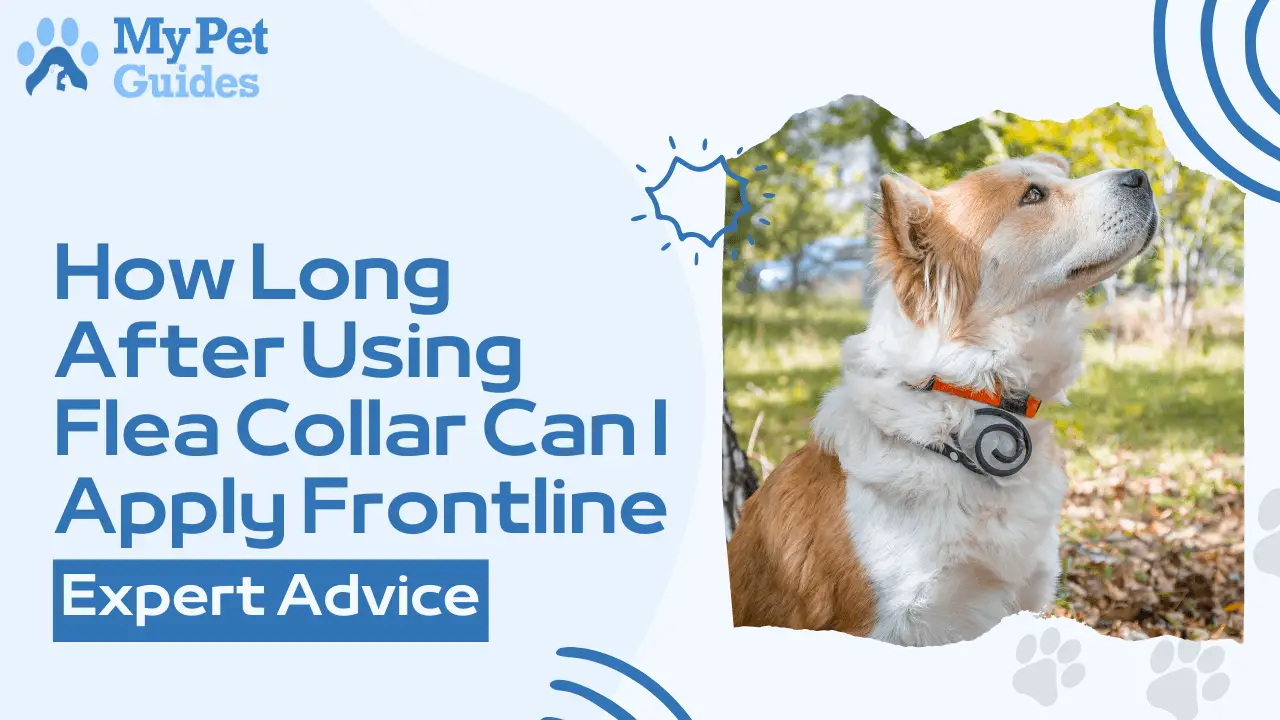Pet owners dealing with flea infestations in their furry friends often turn to flea collars and topical flea treatments such as Frontline. However, it can be unclear to determine which method is best to use and when to use them. In particular, pet owners may wonder how long they should wait after using a flea collar before applying Frontline.
According to Lets Healthify, pet owners should wait at least 30 days before applying Frontline after using a flea collar. This allows the chemicals from the flea collar to be fully processed and out of the pet’s system. Applying Frontline too soon after using a flea collar can result in an overdose of the active ingredients, which can cause a loss of coordination in pets.
It’s important to note that pet owners should never mix flea products, such as using both a flea collar and a topical treatment simultaneously. This can be dangerous for pets and lead to an overdose of flea-killing chemicals. By waiting the recommended time between treatments, pet owners can ensure that their furry friends are protected from fleas without risking their health.
How Long to Wait Before Applying Frontline Plus
When using a flea collar on a pet, knowing how long to wait before applying Frontline Plus is essential. Frontline Plus is a topical flea and tick treatment applied directly to a pet’s skin. It is essential to follow the instructions carefully to ensure the medication is effective and safe for your pet.
According to PetMD, waiting at least 24 hours after removing a flea collar before applying Frontline Plus is recommended. This waiting period ensures that any residual flea collar chemicals have dissipated and the skin is free from any irritation or residue that could affect the Frontline Plus’s effectiveness.
It is also important to note that Frontline Plus should not be applied to wet skin. If a pet has been bathed, it is recommended to wait at least 48 hours before applying Frontline Plus, as stated by DoggySaurus. This waiting period allows the pet’s skin to produce natural oils, which help the Frontline Plus medication to spread evenly across the skin.
If a pet has been using a different flea and tick medication, it is recommended to wait at least three to four weeks before switching to Frontline Plus, according to PetMeds. This waiting period ensures the previous medication has entirely dissipated from the pet’s system, and the Frontline Plus will not interact with it.
In summary, waiting at least 24 hours after removing a flea collar and 48 hours after bathing before applying Frontline Plus is recommended. Additionally, if switching from a different flea and tick medication, it is recommended to wait at least three to four weeks before using Frontline Plus.
How Flea Collars and Frontline Work
Flea collars and Frontline are two of the most popular pet flea treatments. Understanding how these products work is essential for pet owners who want to keep their furry friends free from fleas and ticks.
Flea Collars
Flea collars work by releasing chemicals that repel fleas and ticks. The active ingredients in flea collars vary depending on the brand, but most contain chemicals like pyrethroids, organophosphates, or carbamates. These chemicals are designed to kill fleas on contact and to repel them from the pet’s fur.
Flea collars are easy to use and can provide long-term protection for pets. However, it is important to read the label carefully and follow the manufacturer’s instructions to ensure the collar is used safely and effectively.
Frontline
Frontline is a topical flea treatment applied directly to the pet’s skin. The active ingredient in Frontline is fipronil, which kills fleas on contact. Frontline also contains an insect growth regulator (IGR) called (S)-methoprene, which prevents flea eggs and larvae from developing into adult fleas.
Frontline is easy to apply and provides long-lasting protection against fleas and ticks. It is important to follow the manufacturer’s instructions when using Frontline to ensure the product is used safely and effectively.
Using Flea Collars and Frontline Together
Pet owners may wonder if using flea collars and Frontline together is safe. The answer is yes, but it is essential to read the label on each product carefully before combining them. Some flea collars are safe to use with Frontline, while others are not. Pet owners should also be aware that using multiple flea treatments simultaneously can increase the risk of adverse reactions.
In conclusion, flea collars and Frontline are effective flea treatments that help keep pets free from fleas and ticks. Pet owners should read the label carefully and follow the manufacturer’s instructions to ensure these products are used safely and effectively.
Timing Between Flea Collar and Frontline Application
Pet owners often wonder how long they should wait before applying Frontline after using a flea collar on their pets. While flea collars and Frontline are effective at treating flea infestations, using them correctly and with the right timing is important to ensure maximum effectiveness.
According to Lets Healthify, the maximum time to wait before applying Frontline Plus after using a flea collar is 30 days. This allows the chemicals from previously applied products to be fully processed and out of the pet’s system. Applying Frontline too soon after using a flea collar can lead to overexposure to chemicals, harming pets.
It is important to note that the timing between flea collar and Frontline application may vary depending on the type of flea collar used. Some flea collars may contain different chemicals or active ingredients, requiring a longer time before applying Frontline. Pet owners should always read the instructions on the flea collar packaging to determine the appropriate waiting period.
If a pet owner needs to reapply Frontline, it is recommended to remove the flea collar before applying the next dose. This is because the chemicals from the flea collar may interfere with the effectiveness of Frontline. Pet owners should also wait 30 days before reapplying the flea collar after using Frontline.
Pet owners should wait at least 30 days after using a flea collar before applying Frontline. The waiting period may vary depending on the type of flea collar used, and pet owners should always read the instructions on the packaging. When reapplying Frontline, removing the flea collar and waiting at least 30 days before reapplying it is recommended. Following these guidelines, pet owners can effectively treat flea infestations without harming them.
Considerations for Cats and Dogs
Regarding flea treatment, pet owners often wonder if they can use a flea collar and Frontline simultaneously. The answer is yes, but it’s essential to consider a few factors.
Type of Flea Collar
Firstly, it’s important to note that not all flea collars are created equal. Some flea collars may contain ingredients that can interact with Frontline or other flea treatments. Pet owners should always read the label carefully before using any flea collar in combination with Frontline. Certain flea collars, like Preventic, are generally safe to combine with Frontline Plus, Revolution, Pet Armor, Frontline Top Spot, Farnam Bio Spot, K9 Advantix II, Advantage II, Trifexis, Interceptor, Certifect, or Advantage Multi, according to PetCareRx.
Waiting Period
Pet owners should also know the waiting period between applying a flea collar and Frontline. The chemicals within a flea collar are typically released within 24 hours of putting it on, and it begins killing and protecting your pet from fleas at around three weeks. Still, again, this depends on the type of collar you have used, according to Lets Healthify. It is generally recommended to wait at least 24 hours after applying a flea collar before applying Frontline or any other flea treatment.
Weight and Age of Pet
It’s essential to use the appropriate weight range for your pet and to ensure that the flea treatment is appropriate for their age. Some flea treatments are only suitable for cats or dogs of a certain age or weight range. Pet owners should read the label carefully before applying flea treatment.
Overall, pet owners can use a flea collar and Frontline simultaneously. Still, they should always read the label carefully and wait at least 24 hours after applying a flea collar before applying any other flea treatment. By considering these considerations, pet owners can help protect their cats, dogs, and puppies from fleas and other parasites.
Frequently Asked Questions
Can you use flea medicine and a flea collar at the same time?
Yes, you can use both flea medicine and a flea collar simultaneously. Spot-on flea treatments like Frontline kill adult fleas, while flea collars keep off new ones from your cat or dog. However, it is important to remember that not all treatments are the same. Be sure to read the label on each product carefully before combining it with a flea collar.
How soon can I apply Frontline after using a flea collar?
Waiting at least 24 hours after removing a flea collar before applying Frontline is recommended. This ensures that any residual chemicals from the flea collar are no longer present on your pet’s skin and will not interfere with the effectiveness of the Frontline treatment.
What happens if you apply to Frontline too soon?
If you apply Frontline too soon after using a flea collar, it may cause an overdose of the active ingredients, which can result in adverse side effects. Symptoms may include skin irritation, hair loss, vomiting, diarrhea, and lethargy. It is essential always to follow the instructions on the Frontline packaging and wait the recommended amount of time before applying the treatment.
How long should I wait between worming and flea treatment?
It is recommended to wait at least 48 hours between administering a worming treatment and applying a flea treatment like Frontline. This allows your pet’s body time to process the worming medication and avoid any potential interactions with the flea treatment.
Is it safe to use Seresto and Frontline together?
Seresto and Frontline should not be used together as they contain the same active ingredient, fipronil. Using both treatments simultaneously can lead to an overdose of the active ingredient, resulting in adverse side effects.
Can I switch from Seresto to Frontline?
Yes, you can switch from Seresto to Frontline. However, waiting at least 24 hours after removing the Seresto collar before applying Frontline is recommended. This ensures that any residual chemicals from the Seresto collar are no longer present on your pet’s skin and will not interfere with the effectiveness of the Frontline treatment.



